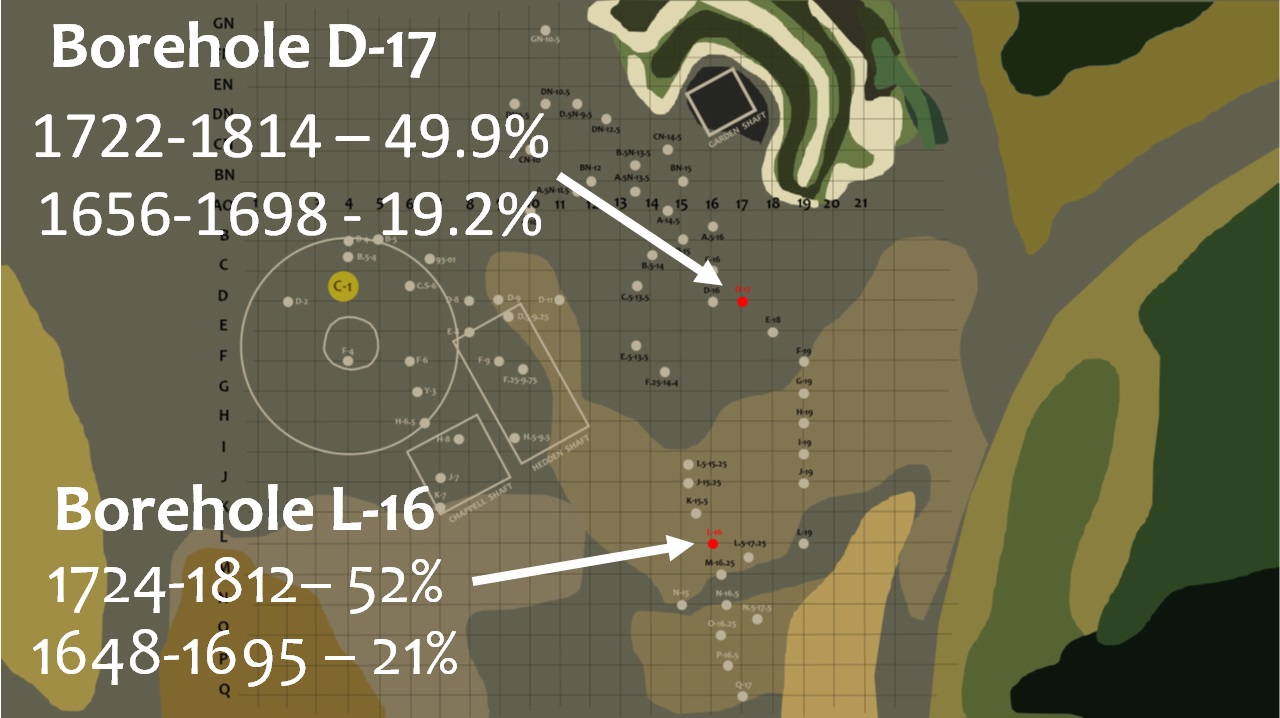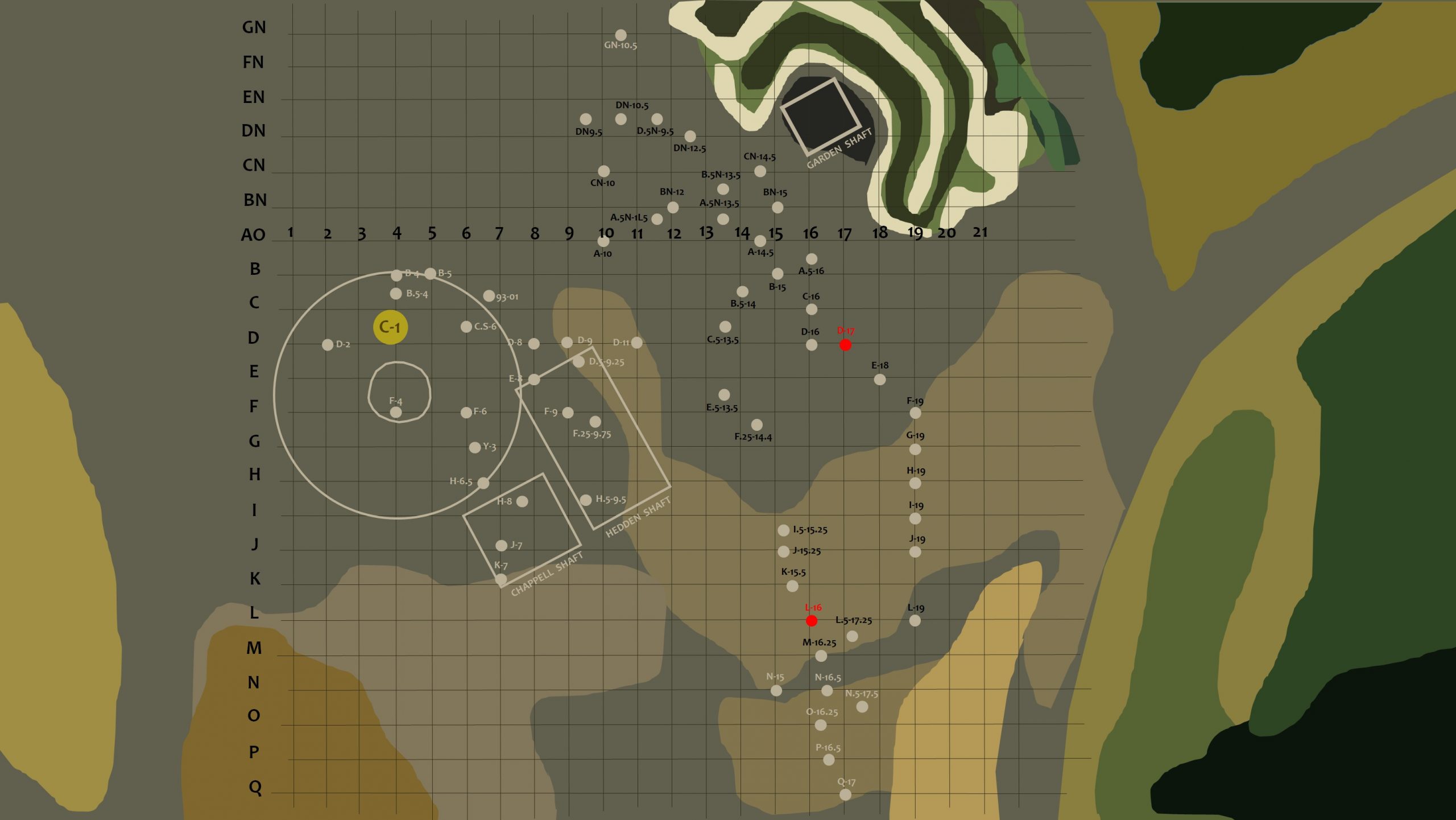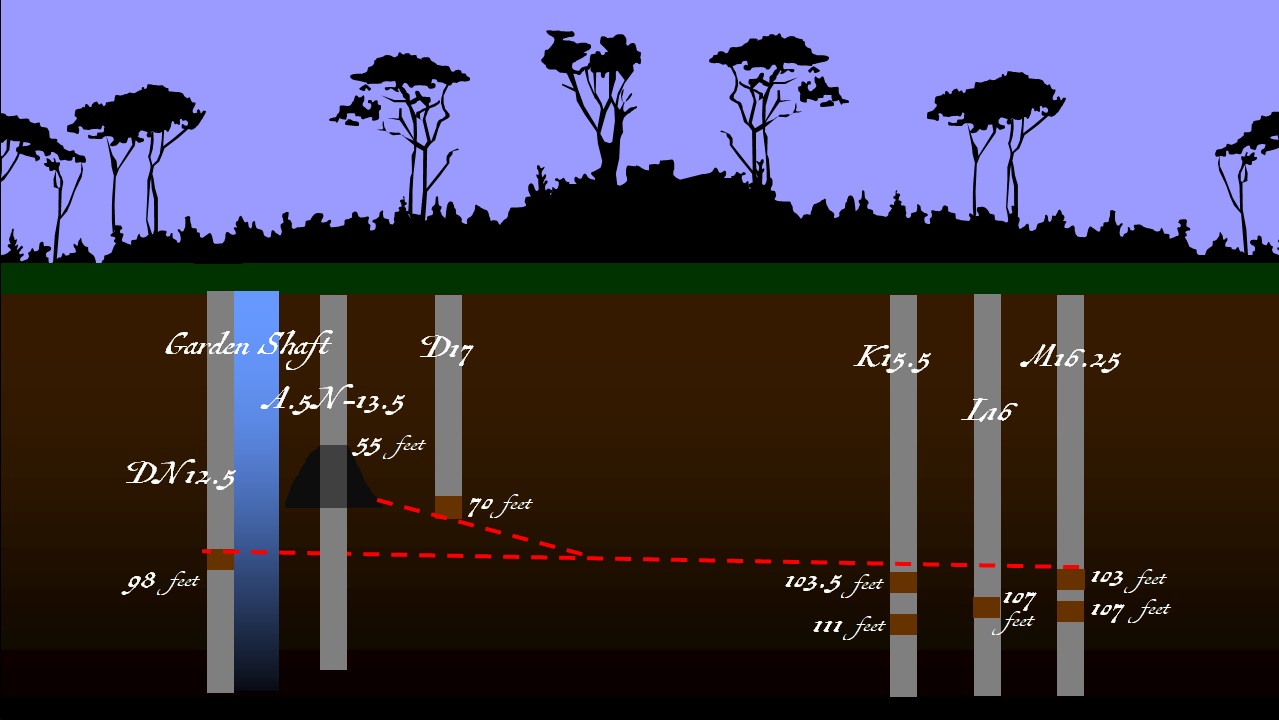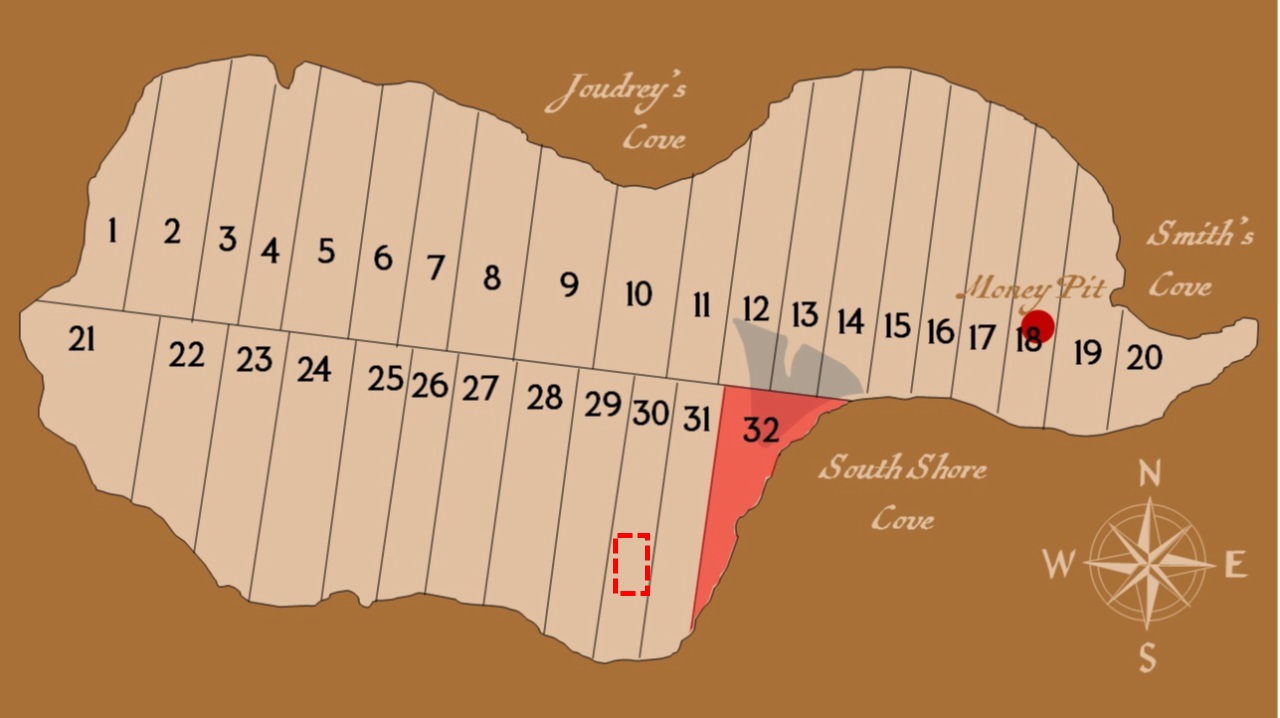The Curse of Oak Island: Season 10, Episode 4 Review
Garden Shaft Rehab Project
The episode begins at the Garden Shaft, where members of the team meet with Paul Cote, Daniel Mackenzie, Al Couture, and Cameron Wile of Dumas Contracting Ltd. – an underground mining company which has agreed to refurbish the Garden Shaft. The narrator then says something very interesting which sheds some light on the mystery of the Garden Shaft – a structure which this author, despite having thoroughly chronicled every episode of the show from the pilot through Season 8, Episode 6, did not recall at all when he first heard it mentioned in the Season 10 premiere. “Located on the eastern edge of the Money Pit area,” the narrator says, “the 10 by 10-foot-diameter Garden Shaft was uncovered by the team back in 2017 [i.e. Season 5]. Although they first believed it had been built in the 1800s by previous treasure hunters, recent wood samples taken some 80 feet deep have been scientifically dated to 1735, over half a century before the Money Pit was discovered.” While the narrator speaks, we are shown old footage of the Lagina brothers, Charles, Barkhouse, and Dan Henskee measuring a wall of vertically-aligned wooden timbers in a shallow excavation pit. A title superimposed over the video dates the footage to 2017.
I did a little digging into the mystery of the Garden Shaft, and will tell you what I found later on in this piece.
Scott Barlow explains to the Dumas Contracting representatives that the Garden Shaft is of interest because traces of aqueous gold were found in it the previous year. Rick Lagina mentions the underground tunnel discovered in Season 10, Episode 1, and states that it’s possible the tunnel connects with the Garden Shaft. The contractors then explain that they plan to build a concrete platform around the top of the shaft before recribbing it from the top down.
Borehole L-16
Later in the episode, members of the team conduct a water test in Borehole L-16. As the operation unfolds, Terry Matheson explains that, while drilling the hole, Choice Drilling came across a fragment of wood at a depth of 106.5-107 feet, sandwiched between in situ soil. He speculates that the wood is part of the underground tunnel the crew has been following throughout the season. Rick Lagina suggests that the wood ought to be carbon dated.

The wood’s carbon dating is revealed in a War Room meeting at the end of the episode. Craig Tester explains that it was dated from 1724-1812 with a 52% degree of accuracy, and from 1648-1695 with a 21% degree of accuracy. Marty Lagina summarizes the findings by saying, “fifty percent in periods that could not be searcher.” He goes on to state that no searcher was known to have constructed tunnels in the area of L-16 in the early 1800s, implying that the wood probably comes from a tunnel constructed by the original depositors.
Borehole D-17
Later on, Choice Drilling sinks Borehole D-17 20 feet south of the Garden Shaft. The drill intersects wood at depths of 70-71.5 feet – a depth which the treasure hunters agree is unusually shallow. Terry Matheson explains that, below 72 feet, the soil was soft and devoid of wood, which he believes is indicative of another tunnel. The Lagina brothers observe that this potential tunnel is shallower than the tunnel they have been following throughout the season, and suggest that, if the two tunnels are connected, this new tunnel would necessarily run uphill. “If you find a tunnel going upwards,” Marty says, “it almost has to be an offset chamber. There’s no point in having an upward-facing tunnel, is there?”

In a War Room meeting at the end of the episode, Craig Tester reveals that the carbon dating of the wood found in D-17 is almost identical to that of the L-16 wood – namely 1722-1814 with a 49.9% degree of accuracy, and 1656-1698 with a 19.2% degree of accuracy – indicating that the two hypothetical underground tunnels were built at the same time. The wood’s carbon dating, coupled with an observation made by Doug Crowell that the relatively shallow depths at which the pieces were found are inconstant with both known and hypothetical searcher activity, indicates that the wood is part of some tunnel system constructed by the Money Pit builders.

The Lot 30 Anomaly
In another scene, the crew congregates in the War Room to discuss the results of the LIDAR scan conducted by Keith Hollender and Robert Seddon on Lot 32 the previous episode, which we now learn was performed throughout the entire island. Dr. Ian Spooner and Steve Guptill, who reviewed the data, tell the treasure hunters about a large rectangular anomaly on Lot 30 which has a dimension of 100 x 150 feet. Jack Begley speculates that this anomaly might be connected with a potential wharf on nearby Lot 32, evidence of which the treasure hunters discovered throughout Season 9.

Laird Niven, on his own recommendation, begins to excavate an archaeological test pit over top of the Lot 30 anomaly, assisted by Rick Lagina and fellow archaeologist Helen Sheldon. The narrator explains that the archaeologists will dig a series of test pits in a grid pattern throughout the anomaly.
Lot 32 Artifacts
In another scene, Gary Drayton and Jack Begley go metal detecting on Lot 32. After some clearly difficult digging, the pair unearth what Drayton identifies as a broken fragment of an 18th Century fire grate. In the same hole, Begley finds two thick cylinders of hand-forged iron which Drayton believes to be quite old, but is unable to identify. After getting another signal in yet the same hole, the pair keep digging and unearth a very large iron pin, which Drayton suggests could be either a tool or a wharf pin.
Later in the episode, Drayton and Begley show the Lot 32 artifacts to the Lagina brothers and Laird Niven in the Oak Island Interpretive Centre. Niven concurs with Drayton’s assessment that the flat piece of iron might be part of a stove grate. Marty Lagina suggests the largest iron pin might be a rock chisel, like the hand point chisel found at Isaac’s Point back in Season 7, Episode 1, or the rusted iron chisel found on Lot 27 in Season 7, Episode 5.
In the next scene, Jack and Gary return to Lot 32 accompanied by Laird Niven, Rick Lagina, and Marty Lagina, the latter driving a backhoe. Under Laird’s supervision, Marty digs a large hole at the spot where Jack and Gary found the four iron artifacts and uncovers a sizeable sheet of lead, which he calls “300 year old duct tape”. Gary opines that the old piece of repairing material has something to do with shipping, explaining, “They used to line the hulls of old sailing ships with lead sheeting.”
Shortly thereafter, Drayton pulls another artifact from the enlarged hole, which Niven suggests looks like a handle. “Could be off like a little ship’s stove,” Drayton suggests.
Gary continues to draw more artifacts from the pit, including a strange leaf-shaped piece of metal which Niven says is hand-forged; a large slightly convex square of iron which Drayton suggests was part of a cooking pot; a flat, mushroom-shaped piece of iron; a mechanical-looking iron object which Drayton identifies as a component of a fireplace; a square of metal bearing a scallop design; and an old iron strap which may have been part of a chest. Laird Niven says that he is impressed with the site, and tells the treasure hunters that he will subject the artifacts to CT scans. In a later interview, he says, “The agreement we have with the province is that if Gary finds a concentration of artifacts, we’ll go in, set up a test unit in that area, and determine whether or not those finds are significant.”
What is the Garden Shaft?
At the beginning of this video, I said that I would tell you about my investigation into the mystery of the Garden Shaft – a structure I don’t recall being mentioned prior to Season 10. At the beginning of this episode, the narrator gave us some clues as to the identity of this mysterious structure, saying that it was discovered in 2017, was initially believed to be a searcher shaft, measures 10’ x 10’, and that wood taken from its 80-foot depth was dated to 1735.
I spent more time than I care to admit going through my book The Oak Island Encyclopedia and my synopses of Seasons 7 and 8 in an effort to find some reference to a structure resembling the Garden Shaft. I can say with some confidence that, contrary to the implications made in this episode, no such structure was discovered in Season 5, which chronicles the 2017 treasure hunt, the only finds bearing even vague resemblance to it being the Chappell Shaft, which was intersected by Borehole H8 in the Money Pit area – incidentally, the same borehole which yielded fragments of human bone – and the mysterious U-Shaped structure on Smith’s Cove, which the crew was able to fully uncover through the use of a cofferdam in Season 6.
In Season 6, the crew members located Shaft 6, a searcher shaft built by the Oak Island Association in 1861, the top 111 feet of which Robert Dunfield dug up in the 1960s. They also found several wooden walls buried beneath Smith’s Cove, which they speculated were driven into the earth in an effort to stem the Smith’s Cove flood tunnel. None of these structures appear to be the Garden Shaft.
And in Season 7, the crew uncovered what they believed to be Shaft 9, a searcher shaft built in 1863 by the Oak Island Association. Although this structure vaguely resembles the mystery shaft depicted in the 2017 footage, Shaft 9 measures 6’ x 12’ – dimensions inconsistent with the 10’ x 10’ Garden Shaft.
The only clue as to the existence of the Garden Shaft which this author was able to find in the show appears near the end of Season 7, after the crew uncovered the top of aforementioned Shaft 9. In an interview, Marty Lagina said, “It’s really cool whenever we unearth one of these shafts. Rick and I did one a couple years ago, and now Rick basically did this one. Every time I look down into a pit like that and see those massive timbers, and see how hard it was to do with an excavator, and then realize it goes down another – what, 90 feet? … I’m always in awe of what these people did. And these were the searchers. Forget about the original depositors.” As there is no other published discovery to which Marty’s reference applies, the unnamed shaft which Rick and Marty discovered “a couple years ago” could very well be the Garden Shaft.
It is interesting to note that the 1735 dating of the 80-foot-deep wood from the Garden Shaft accords perfectly with wood found in the swamp in Season 4, Episode 3, which was carbon dated from 1680-1735; and with wood found at a depth of 52 feet near Smith’s Cove in Borehole OITC-6, dated from 1735-1784, which some of the crew strongly believed to be a piece of the Smith’s Cove flood tunnel.
I owe this next and final piece of information on the Garden Shaft to my friend, Evelyn, who sent me a screenshot of a Facebook post made by Oak Island tour guide Lisa Moore.
“A question that comes up a lot,” Lisa wrote, “especially from folks who haven’t been out on a tour; is one regarding the ‘rock structure’ now seen at the Money Pit site.
“Well, it’s not ‘X marks the spot’ (unfortunately!) or THE Money Pit, but actually a landscape feature designed and built by Rick Lagina. This beautiful multi-tiered rock garden surrounds the ‘mystery shaft’ – a searchers shaft discovered nearly intact during the second season of the ‘big dig’. The shaft, which isn’t entirely excavated, tends to flood seasonally from underground and surface water, sometimes obscuring it from view. We have a few guesses, but no solid answer as to who dug this shaft as its location doesn’t seem to line up just right with our historical maps of the area.
“The garden is filled with beautiful trees, shrubs and flowers… It is Rick’s ‘living memorial’ to the ‘women of Oak Island’ – past, present, and future – who have, are, and will play a pivotal role in solving this centuries’ old mystery.”
Leave a Reply